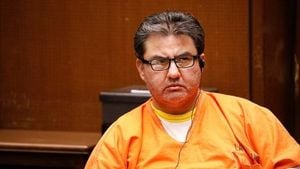Market participants are buzzing with speculation as the Federal Reserve approaches its highly anticipated interest rate decision set for November 7. With just days left before policymakers convene, there's palpable excitement, particularly since nearly all investors are betting on a quarter-point rate cut. Recent data from the CME FedWatch tool suggests there's a staggering 96% chance of this happening, indicating broad confidence among traders as they analyze the impact of economic conditions and political climate on monetary policy.
But before the big meeting, the Fed enters its usual blackout period, during which officials refrain from any public statements. This silence heightens the intrigue surrounding the decision, especially as traders and analysts try to interpret the signals coming from various Fed officials. There are mixed views among these policymakers. For example, Minneapolis Fed President Neel Kashkari recently hinted at expected "modest cuts over the next quarters," aligning with the idea of one or two adjustments to keep the economy on track. On the other hand, some officials like Atlanta Fed President Raphael Bostic prefer to take their time, assessing the incoming data rather than committing to any immediate cuts.
Recent economic reports and labor statistics play pivotal roles leading up to the Fed's decision. Scheduled releases include the Personal Consumption Expenditure (PCE) price index for September and employment data for October. These figures are particularly interesting as they may reflect the effects of hurricanes and labor strikes on the job market. Christopher Waller, the Fed Governor, warned last week about potential shortfalls of over 100,000 jobs owing to these disruptions, which could push the unemployment rate higher temporarily, adding yet another layer of complexity to the Fed's calculations. Despite these potential setbacks, Waller was optimistic about the labor market remaining on solid footing, underscoring his support for gradual rate cuts.
Interest rates have directly influenced market movements, with September’s 50-basis-point cut leading to significant gains for U.S. equity markets. The S&P 500 surged approximately 3% since mid-September, peaking on October 17, bolstered by investor optimism. The tech-heavy Nasdaq 100 saw even sharper growth, rising roughly 4% within the same timeframe. This upward trend showcases market resilience but leaves investors with questions about the sustainability of this growth, especially with upcoming elections looming large on the horizon.
The uncertainty surrounding the approaching presidential election injects additional tension to market sentiment. Political dynamics could greatly influence investor confidence, particularly as debates continue over economic policies promoted by various candidates. With projections from the International Monetary Fund (IMF) indicating the U.S. budget deficit may continue to widen, long-term fiscal stability remains at the forefront of discussions among economists and financial analysts alike. Concerns over the possible ramifications of these fiscal pressures are evident, as they could complicate the Federal Reserve's ability to navigate both inflation control and economic growth effectively.
Aside from potential rate cuts, traders are also keeping their eyes on corporate earnings as third-quarter reports flood the market. With interests spanning various sectors, these earnings will provide clear indicators of individual performance across companies against the backdrop of shifting economic conditions. For example, gold and oil prices have shown recent increases, attributed to escalated tensions in the Middle East, leading to flows of investment pivoting toward more stable assets as traders seek refuge from potential volatility.
Meanwhile, amid the chatter of impending rate changes, European and U.S. stock markets faced dips on October 22, driven by traders weighing the overall outlook for U.S. interest rates. The Dow and S&P 500 had previously soared to record highs but showed vulnerability as their momentum met the realities of impending fiscal and political developments. Investors’ hesitance reflects the reality of the election's influence on the Fed's immediate actions, underscoring how pivotal these forthcoming decisions can be.
Looking to the future, the interplay between the Federal Reserve’s rate decisions, aging economic indicators, and active political tensions will shape not only market dynamics but individual investment strategies moving forward. How will the Fed work to maintain stability within the economy? Will the impending elections force adjustments to federal policy? Essentially, investors must navigate through both economic currents and political winds as they prepare for what's next.
With time ticking down to the Fed’s meeting, all eyes will remain focused on the central bank's decisions, as shifts to monetary policy could set the tone for markets and economic expectations.



